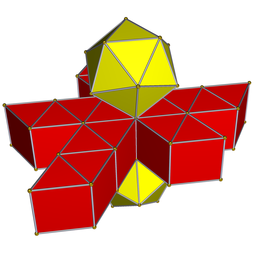Icosahedral prism
| Icosahedral prism | |
|---|---|
 | |
| Rank | 4 |
| Type | Uniform |
| Notation | |
| Bowers style acronym | Ipe |
| Coxeter diagram | x o5o3x ( |
| Elements | |
| Cells | 20 triangular prisms, 2 icosahedra |
| Faces | 40 triangles, 30 squares |
| Edges | 12+60 |
| Vertices | 24 |
| Vertex figure | Pentagonal pyramid, edge lengths 1 (base), √2 (legs) |
| Measures (edge length 1) | |
| Circumradius | |
| Hypervolume | |
| Dichoral angles | Trip–4–trip: |
| Ike–3–trip: 90° | |
| Height | 1 |
| Central density | 1 |
| Number of external pieces | 22 |
| Level of complexity | 4 |
| Related polytopes | |
| Army | Ipe |
| Regiment | Ipe |
| Dual | Dodecahedral tegum |
| Conjugate | Great icosahedral prism |
| Abstract & topological properties | |
| Flag count | 960 |
| Euler characteristic | 0 |
| Orientable | Yes |
| Properties | |
| Symmetry | H3×A1, order 240 |
| Convex | Yes |
| Nature | Tame |
The icosahedral prism or ipe is a prismatic uniform polychoron that consists of 2 icosahedra and 20 triangular prisms. Each vertex joins 1 icosahedron and 5 triangular prisms. It is a prism based on the icosahedron. As such it is also a convex segmentochoron (designated K-4.36 in Richard Klitzing's list).
Gallery[edit | edit source]
-
Card with cell counts, verf, and cross-sections
-
Segmentochoron display, ike atop ike
-
Net
Vertex coordinates[edit | edit source]
The vertices of an icosahedral prism of edge length 1 are given by all even permutations and all sign changes of the first three coordinates of:
Representations[edit | edit source]
An icosahedral prism has the following Coxeter diagrams:
- x o5o3x (full symmetry)
- x2s3s4o (






 ) (bases as pyritohedral symmetry)
) (bases as pyritohedral symmetry) - x2s3s3s (






 ) (as snub tetrahedral prism)
) (as snub tetrahedral prism) - oo5oo3xx&#x (bases seen separately)
- xxxx oxoo5ooxo&#xt (H2×A1 axial, edge-first)
Related polychora[edit | edit source]
An icosahedral prism can be cut into a central pentagonal antiprismatic prism augmented with 2 pentagonal pyramidal prisms.
The regiment of the icosahedral prism also contains the great dodecahedral prism.
External links[edit | edit source]
- Bowers, Jonathan. "Category 19: Prisms" (#892).
- Klitzing, Richard. "Ipe".
- Wikipedia contributors. "Icosahedral prism".






